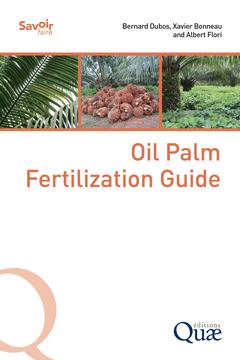Oil Palm Fertilization Guide Coll. Savoir faire
Auteurs : Dubos Bernard, Bonneau Xavier, Flori Albert

Acknowledgements
Preface
Introduction: context and purpose of this guide
1. Understanding oil palm mineral nutrition and diagnosing nutritional needs.
Why fertilize oil palm plantations?
Can deficiency symptoms be trusted to recommend fertilizer applications?.
Nitrogen (N) deficiency
Potassium (K) deficiency.
Magnesium (Mg) deficiency
Boron (B) deficiency
Copper (Cu) deficiency
Manganese (Mn) deficiency
Other nutrients.
Conclusion
Analysing leaf samples to establish a diagnosis.
Ascertaining variability in leaf nutrient contents.
Nitrogen (N)
Phosphorus (P
Potassium (K)
Calcium (Ca)
Magnesium (Mg)
Chlorine (Cl).
Sulphur (S)
Trace elements: boron, copper, iron, manganese
Interpreting leaf contents considering the specific characteristics of a plantation
2. Plantation sampling for ongoing mineral nutrition monitoring..
Dividing the plantation into several leaf sampling units
Planning the leaf sampling schedule
Choosing the palms of the reference sample inside the LSU
Restricting reference sampling to a uniform section of the LSU
When and how to select the palms used for leaf sampling
Taking special leaf samples to check specific zones in the LSU
3. Adapting the decision-support tool to local conditions: taking the specificities of each site into account
Fertilization trial principles
Choice of treatments and experimental designs.
Aggregating data and determining local optimum contents
Experimental precision
Drawing up the fertilizer schedule from the experimental results
Determining the optimum content range per nutrient.
Drawing up a fertilizer schedule from the optimum content range
Applying the conclusions of the experimental approach
A better understanding of trial results
4. Extrapolating fertilizer schedules resulting from trials.
Analysing the plantation reaction on an LSU scale
What information can be drawn from soil analyses?
Taking into account soil calcium contents when using KCl
Detecting distortions due to soil properties
Associating a reference soil analysis with each leaf sample
Constructing a geographic information system (GIS)
Setting up reactivity tests
5. Adopting sustainable fertilization practices: prospects and recommendations.
Preserving soil health
Caring for the chemical fertility of soils
Assessing soil reserves
Improving fertilization efficiency
Reducing mineral nutrient losses through different cultural practices
Improving the physico-chemical properties of soils
Developing a precise and environment-friendly fertilization tool
Precision of recommendations and fertilizer schedules
Spatial precision of leaf sampling and fertilizer application
Conclusion: generic tools for optimized fertilization in each plantation
Bibliography
Albert Flori, an agro-statistician at Cirad, contributes his skills to the improvement of tropical perennial cropping systems by developing experimental protocols and interpretation aids to ensure the reliability of decisions concerning plantation fertilization and the choice of plant material.
Xavier Bonneau, an agronomist specialized in coconut and oil palm at Cirad, has set up an agronomic advice to improve the yields and sustainability of plantations, particularly in Africa and Indonesia. The environmental impacts of agricultural practices are taken into account in his work.
Bernard Dubos, a Cirad researcher, has studied tools for diagnosing the nutrient needs of oil palm plantations throughout his career. In partnership with private companies in Africa and Latin America, he has built a network of trials to optimize the fertilization strategies of each plantation and preserve their sustainability.
Date de parution : 12-2022
Ouvrage de 80 p.
16x24 cm
Thème d’Oil Palm Fertilization Guide :
Mots-clés :
palmier; huile; fertilisation; agriculture; Afrique; Amérique latine



